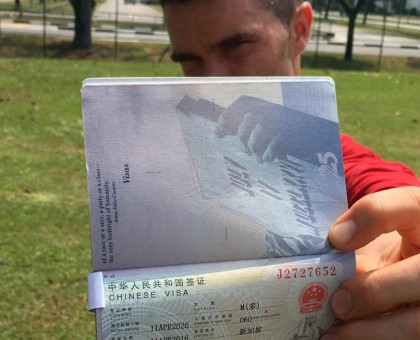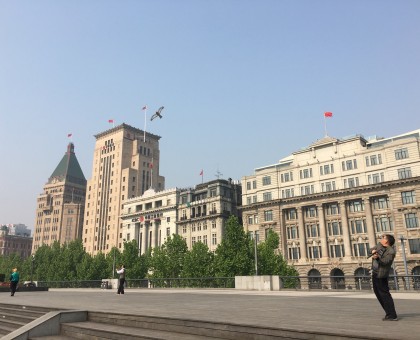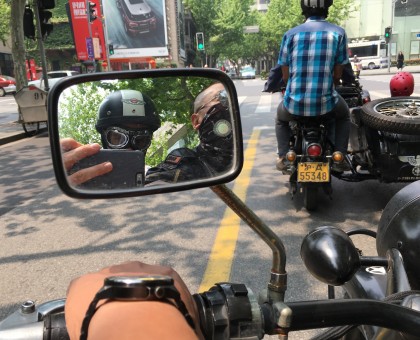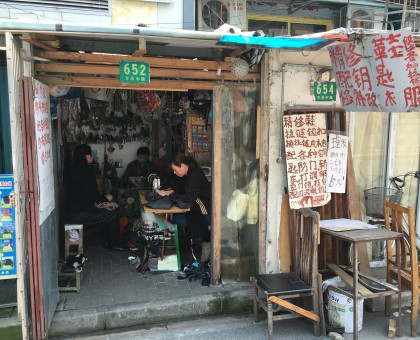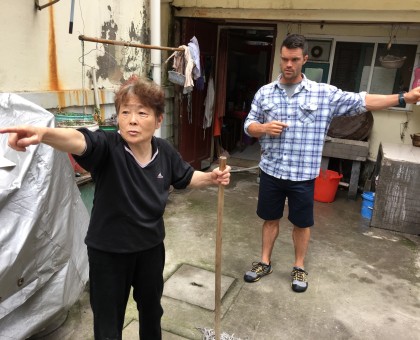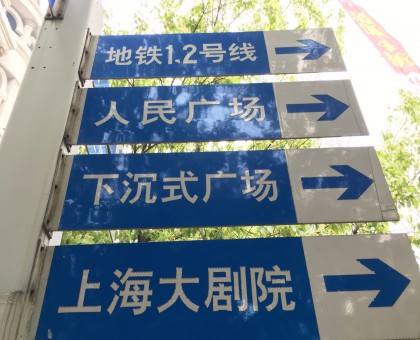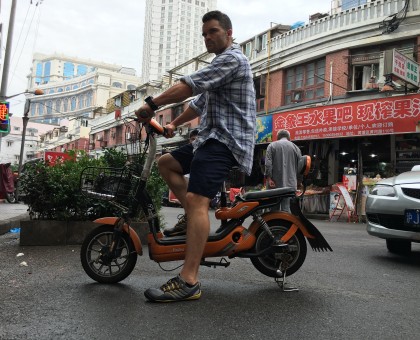.png)
It wasn’t until I opened my passport and saw that I was granted a 10-year visa that it registered with me. I was going to China! Just the thought alone sounds crazy, but as a world traveler, I guess it should come as no surprise that the world’s most populous country would be a place I’d be visiting.
The 5.5-hour flight from Singapore to Shanghai went eerily quickly, and upon landing in the world’s third-most populous city - with more than 23 million inhabitants - I was greeted with a thick cloud of smog. As we landed and took in the sunset, it was nothing more than a small speck of orange in the sky, as it could not cast any colors through the dense layers of smog. Welcome to China.
The journey from the Pudong International Airport into the heart of Shanghai took right around an hour, and as I got closer to my destination, I quickly felt as tiny and insignificant as ever; skyscrapers on both sides of the street towering over me.
Driving along The Bund (Waitan in Mandarin) - the famous waterfront area in central Shanghai - gave me my first glimpse across the Huangpu River to Puxi, and up at the Shanghai Tower (632m / 2,073ft), Shanghai World Financial Center (492m / 1,614ft) and Oriental Pearl Tower (470m / 1,535ft). These three structures stick out of the Shanghai skyline like giants amongst midgets, casting reflections on the Huangpu River from their thousands of multi-colored lights. On the Pudong side of the river, art deco buildings feature a taste of Shanghai’s past. If I didn’t know any better, I would have thought the Pudong and Puxi sides of the river were two different countries; that is how distinctly different their architecture is.
A nighttime journey along The Bund offered a glimpse up at these magnificent structures, and truly put in perspective how gorgeous the Shanghai skyline is. With its beautiful, changing colors, the Oriental Pearl Tower caught my eye from the beginning, and will always be etched in my memory as one of the more unique buildings I’ve seen. To me, it is the symbol of Shanghai. As the night went on, and so did my journey along The Bund, I interacted with locals who were aggressively trying to make a sale. No gimmicks desired here; I left the laser pointers and other gadgets for someone else.
Situated in the middle of The Bund is a statue of Chen Yi, a former Chinese communist military commander and politician. Yi served as the Mayor of Shanghai in the 1940s and ‘50s. It is rumored that the only funeral that the infamous Mao Zedong attended was Yi’s.
A sunrise (16km / 10mi) run along The Bund offered an altogether different perspective of the Queen of the Orient, as a dense smog blanketed the city, and I passed scores of hard-hat-wearing, blue collar locals walking to work. With cigarettes and coffee (in a bag) in hand, they didn’t appear to be happy about where they were going. One of the most interesting things I witnessed during my early-morning adventure through the city was the dozens of locals doing hamstring stretches along The Bund. With one leg propped up on the railing and the other on the ground for support, it seemed like it was a hamstring-stretching convention for Shanghai locals. It wasn’t just a group of them in one location; all along The Bund I saw people getting their stretch on. Stretch on, brother!
Equally as unique were the number of individuals flying kites along The Bund. Handmade, these kites were made to look like birds of prey, and soared ridiculously high once they got going. Some kites were flown hundreds of feet out over the Huangpu River, and looked like a small bird in the distance. It was an impressive sight to see as the kite operators guided them with an immense amount of focus and precision.
One of Shanghai’s notable attractions is the sidecar tour, where a local guide drives a copycat version of a Russian military motorcycle featuring a sidecar. Talk about a fun ride! Navigating through the former French Concession and Shanghai’s Old Town, my perspective from the sidecar offered a street view, literally. The plain trees (that’s actually what they are called) offered a shade-covered ride through the French Concession, which was more than welcome on a hot day in late April. A stroll through Old Town really put things in perspective, as hundreds of exposed power lines and electrical wires draped down over the alleyways and sidewalks in the neighborhoods. Tubs of water sat outside the residences, and I was informed that these were not only the tubs for washing dishes and clothes, but also the people who live there. The simplicity of life for these Shanghai residents was extremely humbling.
One of Shanghai’s symbols is the Waibaidu Bridge (Garden Bridge), which is China’s only remaining camelback truss bridge. Crossing the Suzhou Creek and linking the Huangpu and Hongkou districts, the Waibaidu Bridge is photographed by hundreds of people every day, and is quite popular among tourists and locals. It dates back to 1908 and is regarded as Shanghai’s landmark bridge.
A trip to Shanghai isn’t complete without visiting the Taobao Fake Market. From selfie sticks to suitcases, and iPhones to sports jerseys, this place had everything...and at a very reduced rate. Well, at least it could be bargained down to a very reduced rate. I put on my bargaining cap and did some serious bartering with the typically stingy stall operators. As always, it was fun being shut down, walking away and then being chased to come back. This tactic always works!
Spending time on the Nanjing Road Pedestrian Walkway made for great people watching. Lined with stores and shops - of any and every type - I could have spent hours here just taking in the sights, sounds and smells. Weaving through shopping malls and random buildings along Nanjing Road, I was on a mad hunt for the perfect photo spot, where I’d have a view down the pedestrian walkway all the way to the Oriental Pearl Tower. The seemingly endless hunt was very underwhelming, as I found myself in a corner office unit trying to stick my camera out the window for a photo. In the process, I knocked over a large jug of steaming hot water, spilling it onto my foot. Yikes. Ouch. I guess that’s karma? Touché.
For what it’s worth, the photo was terrible. Talk about an anti climax.
While wandering through the streets of Shanghai, I stumbled upon a park, where a group of locals were shooting hoops. Dressed in a nice shirt and shorts, and donning loafers, I watched from outside the court for about 15 minutes before finally making a move. I headed in and asked if I could play. Well, ‘asked’ is the wrong word I suppose. There was no verbal communication (language barrier, anyone?), so we did our best at Chinese-American charades and finally came to the mutual understanding that I wanted to play in a basketball game with their group. Ah, yes. That’s it!
I’m not sure what the locals expected from a well-dressed American, but I’m guessing it was more than I ended up offering. My hoops game was always average at best, but having taken more than a decade off, I wasn’t exactly sharp. One guy on my team was particularly selfish, and I learned the hard way that no matter when I passed him the ball, no one else ever got it back. He hated passing. The thing is, all of these guys were terrible basketball players - so I fit in well - but they got mad when I didn’t make every shot or get every rebound. I enjoyed my Chinese streetball experience, but will certainly come with a better game if I decide to join in again.
Throughout my journeys through the streets of Shanghai, I found myself interacting with locals far more than I anticipated. Although nothing was communicated verbally - my Mandarin is non-existent and the average Shanghai resident doesn’t speak English - I had fun speaking with my hands and doing my best to ask questions or get information charades style. It worked surprisingly well, and I enjoyed being amongst the locals and seeing how they go about their daily lives.
Getting around Shanghai is relatively easy, and I had a couple different - but both very unique - experiences in getting from A to B. Taxi fares are inexpensive, so I used this mode of transportation on multiple occasions. I’m not sure what the history with taxi drivers and customers is in Shanghai, but apparently drivers’ safety is an issue because they are boxed into the driver’s seat and are surrounded by a hard, thick plastic shield. Maybe the Pope drives a taxi from time to time in Shanghai, so all of the vehicles are equipped with this kind of protection?
Aside from the sidecar experience, the coolest mode of transportation I used was the Maglev Train, which I took from the city to the Pudong International Airport to catch my flight back to Singapore. It is the first commercially operated high-speed magnetic levitation line in the world, and reaches speeds of 400km per hour (249mph). Even though the train I rode only topped out at 301km per hour, it was still incredible to experience. The trip to the airport took just 8 minutes! Cars driving 80-100km per hour (50-60mph) on the highway looked like they were sitting still. Unreal!
My first trip to China was quite the thrill. Being able to take in all that I did in such a short timeframe made my time in Shanghai a fulfilling adventure, but certainly makes me want to visit again.


